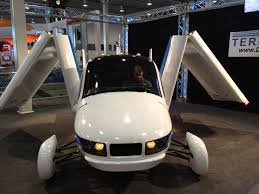Flying Cars in 2025? The Shocking Truth About What’s Really Taking Off
Every few months, headlines scream, “Flying car approved!” or “The future is finally here!” And sure, we’ve seen videos of sleek, drone-like machines lifting off with one or two passengers inside. But let’s not get ahead of ourselves.

Here's the uncomfortable truth: Flying cars technically exist—but no, you're not getting one anytime soon.
Every few months, headlines scream, “Flying car approved!” or “The future is finally here!” And sure, we’ve seen videos of sleek, drone-like machines lifting off with one or two passengers inside. But let’s not get ahead of ourselves. Just because something can fly doesn’t mean it’s ready to replace your Uber—or even your dusty old Corolla.
In this article, we’ll break down:
- What “flying car” even means in 2025 (it’s not what you think)
- Who’s building them—and who’s bluffing
- The tech breakthroughs (and fails) that matter
- The insane infrastructure no one’s talking about
- And the cold, hard reason you won’t be commuting by air next year
Let’s stop dreaming—and start decoding the truth.
What Exactly Is a Flying Car in 2025?
The real tech is more like this: vertical take-off and landing aircraft (aka eVTOLs) that look like oversized quadcopters. They don’t drive on roads. They don’t have four wheels. And nope—they don’t park in your garage.
They’re more like air taxis. Short-range. Lightweight. Battery-powered. Designed for short urban hops, not highway cruising-then-lifting-off like a Transformer.
So, Why Call Them Cars?
Marketing, baby. “Flying car” sounds cooler than “electric vertical aircraft.” And let’s be honest—it sells more headlines.
Who’s Building These Things—and Are They for Real?
A few big names are actually putting serious money behind this. But not everyone claiming “takeoff” is cleared for landing.
Alef Aeronautics: Car-Plane Hybrid (Kind Of)
Alef stunned the world in 2023 when its Model A received FAA approval for flight testing. It’s one of the few that actually drives and flies. Like, legally. But here’s the twist: it can only fly short distances, fits one or two people, and costs a stomach-churning $300,000. So… not exactly ready for mass market.
Joby Aviation: Air Uber, Basically
Backed by Uber and Toyota, Joby’s eVTOL promises 150+ mile range at 200 mph. Quiet, fast, electric—and made for city commutes. They’re testing now, aiming for FAA certification by 2025. But real-world availability? More like 2027+. And that’s if everything goes perfect. (Which it won’t.)
Others in the Game
- Archer Aviation: Soon to launch promising flights in NYC and LA. Let's see.
- Volocopter (Germany): Using air taxis to target the 2024 Summer Olympics in Paris.
- Xpeng AeroHT (China): Part of the EV giant—testing a hybrid vehicle.
Some of these players are legit. Others? Flashy render videos, vague timelines, and hype over hardware.
The Tech Is Almost There—But the World Isn’t Ready
So what’s stopping us from ordering an air Uber today? Oh boy, buckle up.
Batteries Are Still a Weak Link
It needs energy to fly. Lots of stuff. eVTOLs require a recharge after only 15 to 30 minutes of flight. That works well for a test demo, but not so well for actual traffic.
And recharging mid-air? Ha. Not happening.
Noise, Weather, and “Oh God, That’s Falling!”
Flying cars sound cool until one crashes. Or hits a flock of birds. Or gets tossed by wind.
Engineers are putting a lot of effort into making them stable and safe. But now? To place hundreds of these devices in the skies above Mumbai or midtown Manhattan, there are still too many "what ifs."
Let’s Talk About Infrastructure—Because Nobody Else Is
Here’s the part they never show in promo videos: where the hell do these things take off from?
Skyports, Charging Pads, Air Traffic Systems
Flying cars need:
- Vertiports (rooftop takeoff/landing hubs)
- High-speed chargers (good luck installing those everywhere)
- New air traffic control systems for low-altitude flying
- Safety rules, flight corridors, emergency protocols
That’s a lot. And cities barely manage to maintain roads, let alone launch a second level of traffic.
Oh—and if you thought potholes were bad? Wait until a software glitch drops your UberAir into a Whole Foods.
The Economics: Cool Toy, Not Commuter Solution (Yet)
Let’s say flying cars become technically perfect. Quiet. Safe. Legal.
Now ask: Who can afford them?
Most current models cost $250,000 to $3 million. That’s not replacing your sedan—it’s replacing helicopters for CEOs, VIPs, or the ultra-rich.
Even when prices drop, flying taxis won’t cost $5 a ride. More like $100+. So unless you’re balling out daily, it’s not solving traffic for the average commuter.
The Marketing Game: Is This Innovation or Just PR?
Let’s not kid ourselves. A lot of the “flying car” hype is more about stock prices than public transportation.
Companies drop big announcements. Stocks spike. Investors clap. Rinse. Repeat.
Meanwhile, the actual rollout? Delays. More testing. FAA hoops. Regulatory red tape. And by the time something flies, most people have already moved on to the next hype train—er, aircraft.
Here’s the Kicker…
Flying cars aren’t a joke. They’re real machines. They fly. They exist. But they’re not the Jetsons dream we were sold.
They’re niche. Expensive. And honestly? Kinda impractical for everyday people right now.
The dream is alive—but still parked firmly in the future.
Share
What's Your Reaction?
 Like
0
Like
0
 Dislike
0
Dislike
0
 Love
0
Love
0
 Funny
0
Funny
0
 Angry
0
Angry
0
 Sad
0
Sad
0
 Wow
0
Wow
0










